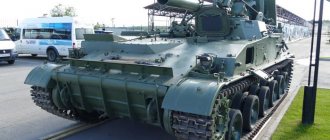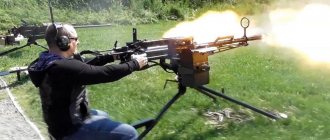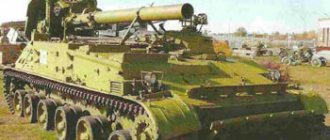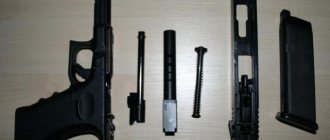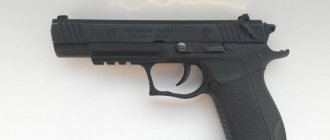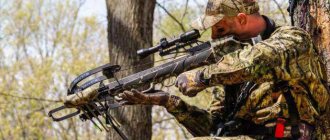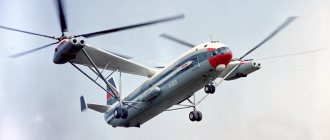The promising artillery armament system of the Red Army, adopted in 1938, provided for the widespread introduction of mortars into the troops: 50 mm - in a rifle company, 82 mm - in a battalion, 120 mm - in a regiment, 160 mm - in a rifle division and, finally , 240 mm - to the artillery of the Reserve of the High Command (RGK). The first three calibers were considered priority - thus, the first sample of a battalion mortar entered service with the Red Army even before the adoption of this program, in 1936. In 1938, company and regimental mortars appeared. The development of heavier systems was slow. The 160-mm mortar was brought to a state suitable for adoption by 1943. But the prototypes of two 240-mm mortars that appeared in the same year were unsuccessful. The design of the system for the RGK artillery had to start virtually from scratch. The work assigned to the Kolomna Special Design Bureau of Smoothbore Artillery (SKB GA) in January 1944 was headed by Boris Shavyrin. In 1944-1945 a prototype of the new mortar underwent factory tests, but after the end of the war they were interrupted and resumed only in 1947. Finally, in 1950, the mortar was adopted by the Soviet Army under the designation M-240. Let us dwell on its design in more detail, since the M-240 is most directly related to the main character of our article.
Mortar 2B9M Vasilek 82 mm Rate of fire. Firing range. Weight
Although 82 mm mortars are usually considered infantry weapons, the 82 mm 2B9 Vasilek automatic mortar should be classified as artillery weapons. This is primarily due to the combat rate of fire of the 2B9, which has a very high value - up to 100 rounds per minute (the rate of fire is 120 rounds per minute), as well as its ability to conduct flat fire and, thus, perform fire support tasks and combat armored targets.
Mortar 2B9 Vasilek - video
Typically, the 2B9 is mounted on a light wheeled carriage, reminiscent of a light field gun carriage, equipped with frames and a tray. In the middle, the barrel is fixed in a rotating device, similar to a drum, which acts as a machine. The magazine-type ammunition receiver supplies 82 mm mines from clips of four mines inserted on the right. The 2B9 can fire along a steep trajectory like a mortar, with the mines being loaded manually from the muzzle, or automatically fire along a flat trajectory like a light anti-tank gun (there is a sight for direct fire) using breech loading from a magazine. To top it all off, when muzzle loading there are three different types of propellant charges, but when loading from the breech the charge is uniform. The recoil force is absorbed by a hydraulic shock-absorbing system installed around the barrel.
The 82-mm Vasilek mortar is also installed on self-propelled chassis; the most common is installation in the back of a 2-ton GAZ-66 4x4 truck. Another option is to install the Vasilka on the cargo platform of a suitably modified MT-LB tracked transporter. Hungary produces a similar version of a self-propelled gun, also assembled on the chassis of an improved MT-LB transporter.
2B9 "Vasilek" is capable of firing standard 82 mm mortar ammunition; The weight of the mine is about 3.1 kg. A special mine with a cumulative warhead has been developed for direct fire at armored targets. The maximum range when firing along a mounted trajectory is 4200 meters.
Modifications
2B9 - basic modification with water-cooled barrel (casing with water)
2B9M - modification with air-cooled barrel - no casing, the barrel walls in the middle part are thickened and have ribs
The 2K21 system is a mobile mortar complex, which includes a transport vehicle (can also be used to tow a mortar when changing firing positions and in emergency situations) 2F54 (a modified army medium off-road truck GAZ-66-05) and the mortar itself
2B9M on the MT-LB chassis (USSR) - military modification of the 2B9M into a self-propelled mortar
2B9M on the MT-LB chassis (VNR) - a slightly modified factory modification of the 2B9M into a self-propelled mortar on the same chassis
Type 99 (export designation for modification of caliber 81.2 mm - W99) - version 2B9M manufactured in China, adopted by the PLA in 1999
The 82-mm self-propelled mortar 2B9M based on the BMP-1 is a Kazakh development; one demonstration copy was presented in May 2014 at the KADEX-2014 arms exhibition. The mortar is openly installed in the middle part of the BMP-1 hull
Artillery review. Part 3. Heavy mortars and ammunition for them
When range is not a key requirement and high angles of attack make it possible to engage targets on reverse slopes or targets hidden in urban canyons, mortars become the weapon of choice. Heavy mortars often became additional weapons even within artillery units. And mortars mounted on vehicles provide motorized infantry units with standard means of indirect fire.
The TDA 2R2M automatic 120-mm mortar system was installed on various chassis, including VAB 6x6 (pictured) and Piranha 8x8
TDA (formerly Thomson Brandt Armements), the mortar division of Thales, many years ago developed the MO 120 RT 120mm rifled mortar, which is in service with many infantry and artillery units. The 622 kg mortar can be towed by a light vehicle or simply transported on the sling of medium multi-purpose helicopters; it has a maximum range of 8.1 km with standard ammunition. A two-meter long barrel provides good accuracy and when firing active-reactive mines, the range increases to 13 km. The mortar is deployed in three minutes, the rate of fire can reach 18 rounds per minute. The MO 120 RT can be divided into three subsystems, the barrel, the base plate and the carriage (the heaviest part weighing 285 kg), and accordingly dropped by parachute. The MO 120 RT mortar is in service in 24 countries, including Belgium, France, Italy, the Netherlands, Turkey and the United States, where it is deployed by the Marine Corps as part of the Expeditionary Fire Support System (EFSS), which can be transported on an Osprey tiltrotor.
US Marine Corps Expeditionary Fire Support System EFSS
On the basis of this mortar, TDA developed the 2R2M mortar (Recoiling Rifled Mounted Mortar - with a rifled recoil system mounted on a vehicle). The 1,500 kg system can be installed in the rear compartment of tracked or wheeled armored personnel carriers weighing 10 to 15 tons thanks to its recoil brake, which absorbs up to 75% of forces. Its computer fire control system, together with a navigation system, allows the first shot to be fired in less than a minute after the vehicle stops. Semi-automatic muzzle loading provides a rate of fire of 10 rounds per minute. The 2R2M can be connected to a common fire control system, which increases firepower at the platoon level and provides automatic data transfer between mortars, control post and forward observer. Ballistic characteristics are identical to those of the MO 120 RT, vertical guidance angles are +45°/+85° and horizontal guidance ±220°. The number of ready shots depends on the platform, but is usually around 35. The 120 2R2M mortar was adopted by the Italian army and installed there on a Freccia 8x8 chassis (the first of 12 mortar complex transporters was delivered at the end of 2014). It was also adopted by the Malaysian army and installed on the ACV-19 vehicle, the Omani army on the VAB 6x6 armored personnel carrier, and in an undisclosed quantity by Saudi Arabia. The 2R2M will most likely be installed on the new Griffon 6x6 vehicle currently being developed for light and medium units of the French army.
Fire from a Cardom ElbitSystems 120mm mortar mounted on an M113 armored personnel carrier; the system can also accept 81 mm barrels and is in service with Israel and Spain Close-up of the 120 mm Elbit Cardom mortar, originally developed by Soltam. The system has now incorporated Elbit's extensive experience in the field of electronics
Another transportable automatic mortar, Cardom, was developed by Soltam, now part of Elbit Systems. It can be armed with a 120-mm or 81-mm smoothbore barrel and is equipped with electric drives for automatic guidance, a modern built-in fire control system (FCS), an inertial navigation system and an on-board ballistic computer that can be integrated into the battle management system, which allows you to shoot the first min after taking the position for 30 seconds.
The 120mm variant has a maximum range of 7,000 meters and a rate of fire of 16 rounds per minute (the number of rounds depends on the type of vehicle). The Cardom mortar can rotate 360°; it can be removed from the vehicle and fired from the ground. In order to increase combat effectiveness, the mortar can fire in MRSI mode (multiple-round simultaneous impact - simultaneous impact of several projectiles; the angle of the barrel changes and all projectiles fired over a certain time interval arrive at the target simultaneously). The mortar was adopted by the Israeli army with a 120 mm barrel (two contracts were signed in 2011 and 2013), as well as by the Spanish army, but with an 81 mm barrel. Cardom is also the basis for the RMS6-L system installed by Mistral Group on 324 Stryker vehicles (known in the US Army as M1129/M1252 Stryker Mortar Carrier).
The American company Mistral Croup has developed the RMS6-L mortar system. It is based on the Cardom mortar from Elbit Systems, the complex was installed on the Stryker vehicle
As a result of further developments carried out by the Marvin Group, the XM-905 mortar appeared, which entered service with American special forces at the beginning of 2014. The program was initiated as an urgent operational need to "broaden the bottlenecks" existing in base protection in Afghanistan. The system, also known as AMPS (Automated Mortar Protection System), is based on a round base plate with three openers and three posts, on which the RMS6-L is actually mounted. The electric drive system is connected to the fire control system in order to minimize preparation for firing; the plate can rotate 360° in both directions. The control system is capable of producing accurate decisions even when the mortar is installed on a slope. In March 2013, Mistral Group was awarded a contract for a new fire control system for the XM-905 mortar, designated EMTAS (Enhanced Mortar Target Acquisition System). At one time (spring 2011), nine such systems were deployed and tested in Afghanistan. The US Army also intends to expand the community of users of the mortar system by supplying it to its special forces units (Green Berets).
AMPS mortar system
Elbit's laser-guided mortar ammunition is achieved by adding a homing head and JDAM kit (a set of rudders and guidance system for conventional bombs) to the standard 120mm mortar ammunition. On the left is the kit installed on the projectile, on the right are individual elements of the kit
Providing infantry with a highly mobile, large-caliber indirect fire system was the goal of Elbit Systems designers when they began work on the Spear system. As a result, they developed a new anti-recoil device that reduces recoil forces to a threshold value of 10 tons, which allows the Spear system to be installed on Humvees without stabilizing supports. The system weighs less than a ton without ammunition; the ammunition load is 36 rounds with charges. The range and rate of fire are the same as the Cardom mortar, loading is only manual and therefore requires a crew of two people. The system is equipped with a computerized navigation and sighting system with an orientation module and clinometers (inclinometers). When receiving data from these systems, the control system (which can be integrated with most battle management systems) uses electric drives to accurately align the mortar barrel in azimuth and elevation. A vehicle equipped with a Spear mortar can open fire 60 seconds after stopping and shoot with an accuracy of 30 meters. With the Spear system, infantry units with light vehicles receive a large-caliber mobile mortar, which allows them to have only one standard type of vehicle for transporting personnel, direct and indirect fire systems. The Israeli army has expressed interest and Elbit says several potential foreign customers are lining up for the system.
About 15 years ago, the Swiss company Ruag developed a transportable 120 mm smoothbore mortar and gave it the name Bighorn (bighorn sheep). The hydraulic system provides guidance and semi-automatic loading, while the inertial navigation and positioning system ensures accurate guidance of the mortar, regardless of GPS or not. The accuracy is 0.5% of the horizontal range and 0.25% of the vertical range. Azimuth guidance is carried out in a sector of ± 190° (optional by adding a slip ring, 360° circular rotation is possible), vertical guidance angles are +45°/+85°. The semi-automatic loading system allows you to fire four rounds in less than 20 seconds, the intense fire mode is 8-12 rounds per minute and the long rate of fire is 4 rounds per minute up to 150 rounds. The maximum range exceeds 9000 meters depending on the type of ammunition. This program was stopped at one time, but in February 2015 the Swiss company showed the Cobra system - a completely modernized version of Bighorn. In addition to the modern “design” in the Cobra system, all hydraulics were replaced with electric drives and a modern control system was installed. The recoil force is 30 tons and lasts only 30 milliseconds, which allows the mortar to be mounted on a two-axle vehicle. The completely new ballistic computer and fire control system are easily integrated into any artillery operational control system. The Cobra semi-automatic loading system allows you to shoot 4 mines in less than 20 seconds (the safety system prevents double loading). According to the Ruag company, a car with the Cobra complex installed can take a position, fire from 6 to 10 shots (the first one leaves the barrel in 60 seconds) and remove itself from it in less than two minutes. The two-meter barrel (in case of limited volume a 1.6-meter barrel can be installed) accepts any current smooth-walled barrel ammunition, even extended guided projectiles. The Cobra complex also includes built-in training tools, as well as an insertable 81-mm barrel, which allows for combat training close to combat conditions at a lower cost and with a reduced range. During the development of the Cobra mortar, some weight savings were achieved; it weighs 1200 kg without a loading system and 1350 kg with it. Ruag has already begun the firing tests necessary to confirm the new architecture (artillery components taken from Bighorn have already fired over 2000 rounds). The Cobra system has already been installed on the Piranha (offered mainly for 8x8 platforms). Negotiations are underway with several countries to purchase this system.
Ruag's Cobra mortar system is the latest addition to the family of 120mm vehicle-mounted mortar systems. The complex, equipped only with electric drives, is based mainly on the previous version of Bighorn
Singapore-based STK Engineering exported its Srams mortar to the United Arab Emirates, where it was installed on the RG-31 vehicle. The entire system received the designation Agrab 1. The twin breech-loading 120-mm Amos mortar manufactured by the Finnish company Patria on the Patria AMV chassis is in service with the Finnish army
The 120-mm Srams smoothbore mortar (Super Rapid Advanced Mortar System) developed by the Singaporean company ST Engineering is in service in Singapore and the UAE, where it is installed on the Bronco articulated all-terrain vehicle and the RG31 mine-protected vehicle, respectively. The mortar has a barrel 1.8 meters long; the complex's semi-automatic loader allows it to achieve a rate of fire of 10 rounds per minute. With an active-missile projectile, the maximum range reaches 9 km, vertical guidance angles are +40°/+80°, while the platform rotates in a sector of ± 28°. The total mass of the system is less than 1200 kg, recoil forces are less than 26 tons (it was installed on ST Engineering Spider cars, as well as on Humvee). In the Singapore Army configuration, it is installed in the Bronco's rear module, and in the case of the RG31, in its rear cargo bed. The first batch of Srams mortars was delivered to the UAE and installed on the RG31 Mk5 armored vehicle by International Golden Group; this self-propelled mortar was called Agrab 1. The second batch of 72 mortars is installed on the RG31 Mk6E armored vehicle. This system was designated Agrab 2; its deliveries continue. The latest variant is equipped with the Selex ES FIN3110 navigation system and, like the first Agrab 1 variant, the Arachnida fire control system from Denel Land System.
Turret mortars are another type of mortar that is mounted on vehicles. Such systems provide the crew (crew) with complete protection. In general, these systems are more complex in design and have greater mass, although the first shot, as a rule, is fired faster, since there is no need to bring the mortar into firing position after stopping the vehicle, only aim it in azimuth and elevation.
In the late 1990s, Patria Hagglunds Oy, a joint venture between Patria and BAE Systems Hagglunds, developed the Amos turret as an indirect fire system for wheeled or tracked armored personnel carriers and fast attack boats. With a mass of 3600 kg, the Amos turret is armed with two three-meter 120-mm smooth-bore breech-loading mortars with a hydropneumatic recoil mechanism. The turret rotates 360°, while the vertical angles are –3°/+85° (motorized). The control system automatically brings the barrels into the firing position, after which the first shot is fired in less than 30 seconds. Loading is semi-automatic, the first four shots are fired in five seconds. The maximum rate of fire is 16 rounds per minute, and the maximum continuous rate is 10 rounds per minute. The long barrel provides a range of over 10 km, and the fire control system in MRSI mode allows you to fire up to 10 projectiles. Following a development contract signed in 2003, 18 Patria AMVs with an Amos turret were ordered by the Finnish Army in 2010; The first deliveries took place in 2013.
In 2006, Patria modified the turret to accommodate the installation of a lighter single-barrel Nemo mortar. It retained the same barrel and most of the characteristics regarding vertical angles, guidance and loading systems, but of course the initial rate of fire dropped to three shots in 15 seconds. The maximum rate of fire is 10 rounds per minute, and the long-term rate of fire is six rounds per minute. The Nemo mortar weighs 1,700 kg (more than half the weight of the Amos), making it compatible with 6x6 platforms and lighter vessels. The first buyer of the system was an unnamed country from the Middle East, but everyone understands that it is the National Guard of Saudi Arabia, which, under a 2010 contract, ordered 36 LAV armored personnel carriers with the Nemo mortar from GDLS-Canada. Orders have also been received to install the system on offshore platforms. According to Patria, interesting opportunities for Nemo are emerging in Europe, the Middle East and North America. In 2012, Patria introduced the Nemo Plus concept, installing the Kongsberg Protector Super Lite remote-controlled combat module and situational awareness system on a mortar turret. In addition, in 2014, Patria introduced the gunner-commander training simulator, which can be used for combat training at various levels. A typical platoon configuration includes three workstations, a gunner-commander position and an instructor-operator position. At the beginning of 2015, Patria and Kongsberg announced a joint agreement to conduct a combat vehicle and weapons system program in one of the countries in the Middle East.
2S1 "Gvozdika" - Soviet 122-mm regimental self-propelled howitzer
Using the experience of modernizing the 2S1 Gvozdika self-propelled howitzer of Soviet origin, the Polish company Huta Stalowa Wola (HSW) developed a turret-mounted mortar and gave it the designation RAK 120. The armament is a single 120 mm mortar with a smooth barrel 3000 mm long, which gives a maximum range of 10 km. The Polish configuration is equipped with an integrated Topaz fire control and communications system and therefore guidance is either fully automatic or carried out via a joystick (there is a manual backup branch). The vehicle's position is ensured by the Talin 5000 inertial navigation system, coupled with GPS and odometer, which guarantees positioning even in the absence of a GPS signal. The guidance drives are electric, vertical angles are –3°/+80°, and horizontal angles are 360°. The automatic loader allows you to load shells at all vertical angles; ammunition and 20 ready-made rounds are placed in the rear niche of the turret; another 40 rounds are stowed in the rear compartment of the vehicle. The rate of fire is six to eight rounds per minute, and the system can fire at least three rounds in MRSI mode. The turret can also be used for direct fire at ranges up to 500 meters. The time to transfer to the firing position is estimated at less than 30 seconds; the vehicle's crew is two or three people and the turret has standard protection that corresponds to the first level of security of the STANAG standard.
After the dual-barrel turret, Patria developed the lightweight single-barrel Nemo turret. The RAK 120mm turret-mounted mortar, developed by the Polish company Huta Stalowa Wola, can be mounted on tracked or wheeled armored vehicles
The RAK 120 turret mortar is mounted on a Rosomak 8x8 armored personnel carrier. The system was ordered by the Polish army
Poland chose the RAK 120, but at first there were no orders for this system; Eight turrets of the first batch were installed on the Rosomak 8x8 wheeled vehicle. However, in 2013, the Polish Ministry of Defense ordered another batch of Rosomak vehicles, 80 of which should be equipped with a turret with a mortar, and the other 43 should be equipped with a command post configuration and a forward observer vehicle. HSW also showed a turret on the Marder infantry fighting vehicle, which was demonstrated at the MSPO 2013 and 2014 exhibitions in order to attract export orders.
In the early 1980s, the Soviet Union began developing a turret with the 2A60 breech-loading 120mm rifled mortar for light wheeled and tracked chassis such as the BTR-80 and BTR-D. In azimuth, the rotation of the tower is limited to a sector of 70°, while the vertical guidance angles are –4°/+80°. The tracked version, designated 2S9 Nona, is apparently no longer offered on the market, unlike the wheeled 2S3 Nona-SVK and the towed Nona-K mortar, which are actively offered to other countries. The maximum rate of fire reaches 10 rounds per minute, the rate of continuous fire does not exceed four rounds per minute. The maximum range with traditional ammunition is 8.8 km and with active-missile projectiles 12.8 km. The mortar is in service with many former Soviet republics; the latest foreign order was most likely an order from Venezuela for 18 systems. A further development of the system was the 2S31 Vena self-propelled mortar based on the BMP-3 with a 2A80 mortar with a longer barrel. The range when firing standard ammunition has increased to 13 km.
China has been able to quickly develop such systems, usually through so-called reverse engineering. The first system was the PLL-05 based on the WMZ 551 6x6 chassis with a turret-mounted mortar mounted at the rear. The mortar turret rotates 360°. The vehicle is equipped with a semi-automatic loading system; the mortar can fire five types of ammunition, including cumulative anti-tank ammunition for direct fire at a range of up to 600 meters. For export orders, the mortar was installed on a Type 07P 8x8 armored personnel carrier. The system received the designation Type 07PA; the first buyer, most likely, was Tanzania, a regular customer of Chinese weapons.
At IDEX 2015, the Sudanese company Military Industrial Complex presented a 120-mm self-propelled mortar based on the Khatim-2 chassis, a very spartan solution for the African market
WIESEL mortar from RHEINMETALL
The German Army's decision to delay the purchase of the lePzMr (leichter Panzermorser, light armored mortar) system, also known as the Mortar Fighting System and based on the Wiesel 2 light tracked vehicle, has de facto stopped the process of arming the German light infantry. The German army received only one system, consisting of eight Wiesel self-propelled mortars, two Wiesel command vehicles, four Mungo ammunition transporters and about 6,000 new generation ammunition. The system is equipped with the Adler DVA information and control system. According to the latest information, full operation of the entire system began in 2015, while infantry units are switching to standard 81-mm mortars.
The Wiesel 2 mortar is based on the 120-mm smoothbore mortar from Tampella (now Patria), already in service with the German army. The barrel is reinforced to withstand the higher pressures created by the new ammunition. The barrel, cradle, recoil device and yoke are fixed on the rotary axis; of the total 310 kg, 180 kg are accounted for by the swinging masses of the gun. The fire control system allows you to open fire in less than 60 seconds after stopping. The forward-facing mortar can rotate in a sector of ± 30°, vertical guidance angles are +35°/+85°. The 1700 mm long barrel and new ammunition allow it to achieve a firing range of 8 km. The rate of fire is three shots in 20 seconds and 18 shots in 180 seconds; The ammunition on board consists of 25 rounds and two guided munitions. Loading is manual, for this purpose the barrel is brought to a horizontal position; therefore it is relatively short. A crew of three works under armor protection; before firing, two stabilizing supports are hydraulically extended at the rear of the vehicle. Mortar systems based on the Wiesel 2 vehicle were intended to arm airmobile brigades of the German army and thus had to be transported inside CH-53 helicopters. The Mortar Fighting System remains in the Rheinmetall portfolio and is also offered for export. The company is evaluating options for installing the mortar on different platforms and is ready to cooperate with manufacturers of other vehicles.
The German government's decision to stop purchasing the Wiesel 2 may reflect the country's desire not to get too deeply involved in current conflicts.
Ammunition
Using its experience in developing the GPS-based PGK (Precision Guided Kit), Alliant Techsystems, with an eye to the US Army's Accelerated Precision Mortar Initiative (AMPI) developed a similar kit designed to improve the accuracy of 120-mm mortar mines , fired from smooth-walled barrels. The MPK mortar precision kit (Mortar Precision Kit) retains the fixed nose section with guide rudders, but has added a tail subsystem with a folding tail unit, which increases the stability of the projectile in flight. Both parts are mounted on the M934 120mm high-explosive fragmentation projectile. APMI requirements call for a circular probable deviation (CEP) of less than 10 meters, compared to a CEP of 136 meters for 120mm smoothbore mortars at their maximum range, which is reduced to 50 meters when using modern high-precision positioning and targeting systems. AMPI ammunition is programmed similarly to PGK artillery rounds using the Enhanced Portable Inductive Artillery Fuze Setter. The MPK was deployed in March 2011 to Afghanistan, where the first MPK-equipped projectile was fired a month later. However, since then the American army has not issued any more contracts for the kit, and ATK is now looking for foreign partners in order to expand the market for its systems.
The Mortar Precision Kit was tested in Afghanistan, but the lack of large orders is forcing ATK to look for foreign partners in order to expand its sales market
ATK is also participating with General Dynamics Ordnance and Tactical Systems in the Perm (Precision Extended Range Munition) program. The goal of the program is to provide the Marine Corps with new ammunition that will increase the range of its Expeditionary Fire Support System on the one hand and significantly increase accuracy on the other (the target requirement for a CEP is less than 20 meters at a range of 18 km). The second participant in the program is a team consisting of Raytheon and Israel Military Industries. An Israeli company has developed a Guided Mortar Munition (GMM120) guided mortar projectile for 120 mm smoothbore mortars. It is equipped with a GPS system and has a range of 9 km. The projectile has four control surfaces, which unfold at the tail after leaving the barrel. Based on guidance signals from the Pure Heart control unit (inertial/GPS), the surfaces are rotated so that the projectile arrives as close as possible to the target (according to the IMI KVO company, 10 meters). For this projectile, a variant with a nose-mounted semi-active homing head with a CEP of less than one and a half meters can also be developed. In February 2014, Israel Military Industries announced that the GPS version of its GMM120 mortar had passed Israeli Army qualification testing.
Another Israeli company, Elbit Systems, has developed a 120mm laser guidance kit for mortar ammunition, which is a variant of the JDAM kit (a set of rudders and a guidance system for conventional bombs). The kit includes a power supply, electronics, controllable nose surfaces and a homing head. Weighing less than 3 kg, the kit provides a wide field of view, is compatible with NATO standard target designators and provides one meter accuracy. However, Elbit Systems is considering the possibility of further improvement. One of the weaknesses of laser-guided mortar mines is that they require a pointer to illuminate the target, while very often mortars are used to neutralize targets beyond line of sight. Targeting from an aerial platform is the best option; however, the infantry does not have such aircraft. So the idea is to use hand-launched UAVs that could illuminate targets. And this is where mass comes into play; the carrying capacity of such devices is quite small. Consequently, it is necessary to develop homing heads with much better sensitivity, which would allow the projectile to be guided at the final part of the trajectory with a very weak reflection of the signal from the target. The Israeli company is actively working on this, but the integration of the GPS guidance system is also progressing. It must be recalled that Elbit also develops drones and its Skylark 2 drone could become an optimal target designator.
The Israeli company MTC Industries & Research Carmiel manufactures a bow rudder control system for 120 mm mortar mines and 122 mm rockets
The fact that Israeli companies are extremely active in the field of 120 mm mortar ammunition should not surprise anyone, since the Israeli army has decided to replace all of its 81 mm mortars with a larger caliber, deploying one four-barrel platoon per battalion. At AUSA 2014, another Israeli company, MTC Industries & Research Carmiel, showed its CAS-0313 bow control system, in which each surface is controlled by a separate DC motor. The angular position of each steering wheel is measured by a potentiometer, and the motor rotation speed is determined by an electronic controller (not included). The system has a length of 212 mm, a diameter of 119 mm, and a wingspan of 370 mm. The wings spread after launch. This system is also offered for 122 mm rockets.
The Russian enterprise KBP has developed a 120-mm Gran guided ammunition. It fires from smooth-bore mortars, the maximum range of action is 9 km. The projectile weight is 27 kg, length is 1200 mm, the warhead is high-explosive fragmentation with an explosive mass of 5.3 kg. It is designed to destroy single and group, stationary and moving, armored and unarmored targets. The lethal radius for unprotected targets is 120 meters. Targets are illuminated by the Malachite portable artillery fire control system. After capturing the target, the Gran projectile is fired. After leaving the barrel, the tail rudders are deployed, after which the main engine is turned on. The gyroscope is then activated and after the projectile begins to orient itself towards the target using the nose rudders, the nose section is separated.
120-mm Gran mortar mine with laser guidance works in conjunction with the Malachite laser target designator
155-mm artillery guided projectile Krasnopol
Performance characteristics of 2B9M Vasilek
— Designer: V. K. Filippov —
— Caliber, mm: 82 — Vertical guidance angles, degrees: from −1° to +78° (firing line height 670 mm) or from +7° to +85° (firing line height 970 mm) — Horizontal guidance angles: ±30°
Weight 2B9M Cornflower
— Weight in combat position, kg: 632 — Weight of transport vehicle 2F54, kg: 3930 — Weight of the entire system in stowed position (with ammunition and crew), kg: 6060
— Time to transfer from combat position to traveling position and back, min.: 1.5 — Carryable ammunition, min., pcs.: 226
— Carriage speed by transport vehicle, km/h: on the highway up to 60, off-road up to 20
— Calculation, people: 4
Rate of fire 2B9M Vasilek
— Maximum technical rate of fire, rds/min.: 170 — Maximum practical rate of fire, rds./min.: 100—120 — Maximum continuous rate of fire, rds./min. (with continuous fire time, min.): 1 min. up to 60, 3 min. up to 33-34, 30 min. to 10
Firing range of 2B9M Vasilek
— Minimum mounted firing range of the O-832DU mine, m: 800 — Maximum firing range of the O-832DU mine, m: 4270 — Number of lethal fragments weighing more than 1 g when used fragmentation mines rupture, pcs.: 400—600 — Radius of continuous destruction, m (mine O-832DU): 6 - Radius of actual damage, m (mine O-832DU): 18
Types of mines 2B9M Vasilek
- 82-mm fragmentation (O-832 (fuzes M-1, M-4, MP-82), O-832D (fuzes M-1, M-4, MP-82), O-832DU, cumulative, smoke ( D-832 - fuses M-1, M-4, MP-82), lighting, propaganda/filled with leaflets (A-832 - fuse OM-82) - Weight of a typical fragmentation mine (O-832DU, shot 3VO1), kg: 3.1 - Maximum weight of the mine used, kg: 4.6 (mine A-832) - Maximum initial speed of the mine, m/s: 272.
The appearance of "Tulip"
The development of the project for the future self-propelled mortar began at OKB-3 under the leadership of G.S. Efimov even before the government decree was issued - in 1966. Actually, OKB-3 was developing the chassis (this area of work was headed by Yu.V. Tomashov) and integrating it with the artillery unit, but the mortar itself for self-propelled guns was created by a specialized artillery design bureau - SKB Perm Machine-Building Plant, headed by Yu.N. Kalachnikov.
The tracked chassis for the Tulip was unified with the Akatsiya - which is understandable, given the development of both self-propelled guns at the same enterprise. The basis was taken from the chassis developed at UZTM in 1955-1965. for the 2K11 “Krug” anti-aircraft missile system. However, the mobility requirements for self-propelled artillery were higher, which required installing a more powerful engine (520 hp instead of 400) and strengthening the structure. As a result, almost 80% of the chassis components had to be redone. There were fewer problems with the artillery part - the developers took the proven ballistics of the M-240 mortar as a basis, adapting the design for installation on a self-propelled chassis. This mortar was designated 2B8. However, the creation of a self-propelled artillery mount in the usual sense - that is, firing directly from the chassis - was out of the question. The obstacle was the enormous recoil force of the large-caliber mortar, reaching 400-450 tf, and also directed almost vertically downwards. No chassis could withstand such recoil - its bottom would break. Therefore, for firing, the mortar base plate is lowered to the ground. That is, it is impossible to fire from the 2S4 on the move - some preparation is required. On the other hand, the presence of an engine made it possible to introduce a hydraulic system into the design of the self-propelled guns, which significantly facilitates the crew’s actions. Its strength has been reduced compared to the M-240 from 11 to 5 people (commander, driver and three crew numbers).
The body of the self-propelled mortar is welded and armored, providing protection against armor-piercing bullets of 7.62 mm caliber and shell fragments. The relative “thin-skinnedness” is explained by the fact that the “Tulip”, by definition, is not a battlefield machine - it is designed to fire from closed positions, “over the heads” of its troops. In the front part of the hull there is a bulldozer blade for self-digging and arranging a firing position, and in the aft part there is a support plate that folds down onto the ground. Functionally, the hull is divided into a control compartment, combat compartment and engine-transmission compartment. The control compartment is located in the bow of the hull between the left side and the engine bulkhead. The driver and commander seats are located here. Above the first position there is a hatch with periscopic observation devices, and above the commander’s position there is a turret with observation devices. A remote-controlled 7.62-mm PKT machine gun, which is the defensive weapon of the Tulip, is mounted on the turret on a ball shoulder strap. Its ammunition capacity is 1500 rounds. The engine and transmission compartment is located in the bow of the hull on the right. It houses the engine, transmission, fuel and air supply systems, lubrication and cooling, heating and starting. The vehicle is equipped with a 12-cylinder, four-stroke, V-shaped, liquid-cooled V-59 diesel engine with forced fuel injection and the ability to operate in afterburner. The transmission is mechanical, two-flow. The gearbox is made in one block with a planetary rotation mechanism.
High-explosive fragmentation mine F-864
The fighting compartment occupies the middle and rear parts of the hull. In the middle part there is ammunition in a mechanized drum-type ammunition rack for 20 minutes, a mechanism for feeding shots and stowage of spare parts. In the roof of the fighting compartment there are two hatches for boarding and disembarking crew numbers, as well as surveillance devices. Along the longitudinal axis of the vehicle there is a hatch for dispensing mines from the ammunition rack. On the aft vertical armor plate there are mounting brackets for the artillery unit.
The undercarriage for one side consists of six double rubber-coated support rollers, four rubber-coated support rollers (two double and two single), a guide wheel and a front drive wheel with removable ring gears and lantern gearing. The suspension is individual, torsion bar with hydraulic telescopic shock absorbers in the suspensions of the 1st and 6th road wheels. Each caterpillar has 115 tracks with rubber-metal joints 482 mm wide, track pitch 125 mm.
The 240 mm 2B8 mortar is mounted on brackets to the rear armor plate. It has a welded membrane-type base plate with a flat base and a bowl for a ball joint for the barrel frame. In the stowed position, the mortar is placed on the roof of the hull, and in the combat position it is lowered to the ground. The mortar cannot be used separately from the chassis. The barrel is a smooth-walled single-layer pipe with a wedge screwed onto the breech. All parts of the bolt, which is designed to close the barrel when fired, are attached here. The breech is a kind of support for the barrel with the bolt when fired; it is it that transfers the resulting force to the base plate. The lifting and balancing mechanisms of the machine are screw type, they are combined into one structure called the lifting and balancing mechanism. With its help, the mortar is aimed vertically and its swinging part is balanced.
Loading operations from a mechanized ammunition rack are controlled from the gunner's and operator's remote consoles, and the shot is fired from the commander's console. The mortar can be loaded from the ground using a crane mounted on the left side of the vehicle, closer to the stern. Rate of fire - 0.8-1 rounds/min. Transfer time from traveling to combat position is 5 minutes. and back - 10 minutes. Vertical pointing angles are possible in the range from +50° to 80°, horizontally - from +10° to +41°. Loading angle - +63°. The sight is an MP-46M panoramic mortar. Vertical guidance is provided by a hydraulic mechanism, horizontal guidance is manual. Hydraulics also ensure the transfer of the mortar from the traveling position to the combat position and back, bringing the barrel to the mine dispensing line, opening the bolt, feeding the mine from the mechanized ammunition rack to the rammer guides (located on top of the vehicle body), loading the mortar, closing the bolt and lowering the barrel into the breech. In short, the designers tried to minimize the need to use “brute male force” by crew members.
Loading the mortar
The supply of mines to the guides of the dispensing mechanism is carried out using three cylinders fixed along the laying axis. The supply of standard mines is carried out alternately by the outer cylinders, active-reactive ones (they will be discussed below) - by one middle cylinder. After dispensing mines from one row, the drum rotates one step relative to the stacking axis, and the next row of mines stands above the cylinder trays. When a lifting command is given, the mine rises with the cylinder upward and rests its body against the guide pipes, after which the cylinder rod goes down, and the mine remains on the guide pipes. After loading the mine with charges and turning the mortar tube onto the loading line, the rammer, resting its base against the stabilizer of the mine, pushes it along the guides into the barrel, after which the rammer's clot returns back
Communication equipment 2S4 - radio station R-123 and tank intercom R-124. The self-propelled gun is equipped with automatic anti-nuclear and fire protection systems. With a mass of 27.5 tons, the self-propelled mortar reaches speeds on the highway of up to 63 km/h. Power reserve - 500 km.
Between May and June 1969, the production of the first three prototypes was completed, and by October 20, factory tests were completed, after which the prototypes were sent for field testing. It must be said that the tests did not go smoothly. The first experimental model at the Rzhevka training ground withstood only two shots. The fastening of the support plate, which rigidly connected it to the body of the machine, burst. And the developing dynamic wave crushed the fuel tanks like an accordion. We had to make changes to the design of the machine. Nevertheless, in 1971, the 2S4 self-propelled mortar was put into service. In 1972 and 1973 The first serial products were ordered - four per year. The small volume of production not least contributed to the increase in the price of the Tulip - it amounted to 210 thousand rubles (for comparison, the 152-mm howitzer 2S3 Akatsiya, produced by the same enterprise and on a similar chassis, cost 36.5 thousand rubles) . Gradually, the production volume of "Tulips" increased, and before production ceased in 1988, 588 of these self-propelled mortars were produced.
Photo 2B9M Cornflower
Mortar 2B9M "Cornflower" based on the MT-LB transporter
Mortar 2B9M "Cornflower" based on the Hummer vehicle
Mortar 2B9M "Cornflower" installed on GAZ-66
Mortar 2B9M "Cornflower" mounted on BMP-1
Similar
SAU 2S7 Pion (2S7M Malka) performance characteristics.
Caliber. Dimensions. Firing range of MLRS BM-21 Grad. Damage area. Rockets. Caliber. Story
120-mm mortar 2B11 complex 2S12 Sani TTX. Firing range. Weight
Mortar 2B9M Vasilek 82 mm Rate of fire. Firing range. Weight
Self-propelled gun 2S3 Akatsiya 152 mm. Firing range. Dimensions. Weight. Engine
SAU 2S1 Gvozdika 122 mm Firing range. Dimensions. Device. Weight
Gun 2A36 Giatsint-B 152 mm. Firing range. Dimensions. Device
MLRS 9K58 Smerch Damage area. Rockets. Caliber. Story
MT-12 Rapier gun. Firing range. Story. Dimensions
Howitzer D-30 122-mm performance characteristics. Firing range. Dimensions. Weight
2S4 Tulip self-propelled mortar 240 mm performance characteristics. Dimensions. Firing range. Weight
Self-propelled gun 2S35 Koalitsiya-SV 152-mm performance characteristics. Firing range. Dimensions. Weight
Howitzer Msta-B (2A65) 152 mm. Firing range. Dimensions. Weight. Ammunition
Self-propelled gun 2S9 Nona-S 120 mm performance characteristics. Firing range. Dimensions. Weight. Armament
AT-T heavy artillery tractor. TTX. Dimensions. Engine. Story
SAU 2S19 Msta-S 152 mm Dimensions. Speed. Engine. Story
MLRS 9K57 Hurricane Damage area. Rockets. Caliber. Story
TOS-1 Buratino (TOS-1A Solntsepek) performance characteristics. Damage area
Divisional gun ZIS-3 76 mm. TTX. Firing range. Dimensions. Weight
Howitzer gun D-20 152 mm performance characteristics. Firing range. Dimensions. Weight
Howitzer M-30 model 1938 122-mm performance characteristics. Firing range. Dimensions. Weight
Self-propelled gun 2S5 Giatsint-S 152 mm performance characteristics. Firing range. Armament. Dimensions. Weight
Self-propelled gun Ferdinand (Elephant) performance characteristics. Reservation. Weight. Dimensions
Self-propelled gun SU-100. TTX. Armament. Dimensions. Shells. Weight. Speed
Self-propelled gun Sturmtiger caliber 380 mm. TTX. Armament. Shells. Reservation. Dimensions
203-mm howitzer B-4 model 1931 performance characteristics. Weight. Ammunition. Dimensions
Self-propelled gun SU-152 St. John's wort 152 mm performance characteristics. Shells. Firing range. Dimensions. Weight
Gun M-46 130-mm performance characteristics. Firing range. Dimensions. Weight
Demining installation UR-77 Meteorite TTX. Armament. Dimensions
MLRS 9K51M Tornado-G. Rockets. TTX. Firing range. Dimensions
SAU 2S31 Vienna 120 mm. Firing range. Story. Dimensions. Weight
German self-propelled gun StuG III. Modifications. Dimensions. Armament. Weight
Guided projectile Krasnopol. TTX. Firing range. Dimensions. Price
Mortar Karl 600 mm and 540 mm performance characteristics. Firing range. Weight. Dimensions
Big Bertha 420 mm gun. TTX. Weight. Dimensions. Ammunition
Self-propelled gun SU-76. TTX. Dimensions. Reservation. Weight. Story
SAU 2S23 Nona-SVK 120-mm performance characteristics. Armament. Range and accuracy of fire. Dimensions
SAU 2A3 Condenser-2P caliber 406 mm Firing range. Armament. Dimensions. Weight
Mortar M-160 caliber 160-mm performance characteristics. Firing range. Ammunition. Dimensions
Airborne self-propelled gun ASU-57. Armament. TTX. Dimensions. Weight. Booking
Artillery complex A-222 Bereg 130 mm. TTX. Firing range. Ammunition
Howitzer BR-18 caliber 305 mm TTX. Firing range. Weight
152 mm howitzer D-1. Firing range. Dimensions. Weight. Device
Mortar M-240 caliber 240 mm. Firing range. Dimensions. Weight
Self-propelled gun SU-85. Ammunition. Reservation. Dimensions. Weight. Engine
Counter-battery radar Zoo-1 (1L219M). Range of control of firing positions. Device
SAU 2S25 Sprut-SD. Caliber. Story. Dimensions. Weight. Engine
Self-propelled gun 2S34 Hosta 120 mm. TTX. Dimensions. Firing range. Armament. Weight
Self-propelled gun ASU-85. Armament. Dimensions. Reservation. Weight
280-mm mortar Br-5 model 1939 Dimensions. Weight. Ammunition
Self-propelled gun 2A45M Sprut-B. TTX. Speed. Engine. Weight
Belarusian MLRS BelGrad. TTX. Firing range. Ammunition. Dimensions
S-23 cannon 180 mm caliber. Ammunition. Weight. Dimensions. Firing range
Self-propelled gun SAU SU-122. Dimensions. Armament. Reservation. Weight
Self-propelled gun Jagdpanther. Weight. Reservation. Dimensions. Armament
Multi-barreled self-propelled gun M50 Ontos. TTX. Armament. Dimensions. Booking
D-74 cannon 122 mm caliber. Firing range. Dimensions. Weight
Artillery tractor T-20 Komsomolets. Armament. Reservation. Dimensions. Weight
Artillery tractor YA-12. Dimensions. Weight. Load capacity. Engine
SAU ISU-122. Armament. Dimensions. Weight. Booking
RPU-14 (8U38) - rocket launcher
2K32 Deva - 82-mm self-propelled mortar system
MLRS BM-24 (T) 240 mm. Firing range. Dimensions. Weight. Engine
Artillery tractor Comintern. Load capacity. Dimensions. Weight. Engine
Self-propelled gun SU-122-54. Reservation. Dimensions. Weight. Firing range
MLRS BM-14-16. Armament. Dimensions. Weight. Firing range
Self-propelled gun Nashorn (Rhinoceros). Armament. Dimensions. Weight. Booking
BR-2 gun caliber 152 mm. Firing range. Dimensions. Weight
Self-propelled howitzer self-propelled gun PzH 2000. Firing range. Dimensions. Weight
BR-17 cannon 210 mm caliber. Weight. Firing range. Rate of fire
Self-propelled gun Vespe 105 mm. Armament. Dimensions. Reservation. Weight
Wheeled self-propelled gun GAZ-68 (KSP-76). Armament. Dimensions. Weight. Engine
Self-propelled gun Brummbar 150 mm. Armament. Dimensions. Weight. Booking
Heavy self-propelled gun SU-14. Reservation. Dimensions. Weight. Engine
Self-propelled gun SU-5. Armament. Reservation. Dimensions. Weight
Self-propelled gun AT-1. Reservation. Dimensions. Weight. Engine
Self-propelled gun SU-12. Armament. Reservation. Dimensions. Weight
